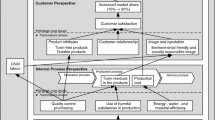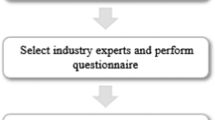Abstract
Sustainability is the major issue of small and medium sized enterprises (SMEs) all across the globe. Although SMEs contribute to GDP of any country their negative contribution to environment is also significant. Prior studies on SMEs’ sustainability mainly classified into three categories—the correlation between environmental and social practices with economic performance, sustainable supply chain performance measurement, and empirical research on sustainability practices. There is no study that objectively derives the sustainable structure of SMEs through optimal combination of sustainability practices (inputs) and performance (outputs). Therefore, the main objective of this paper is to generate optimal structure of sustainable SMEs by combining neural network and particle swarm algorithm while considering Multi-Objective framework. The study uses data from 54 SMEs of Normandy in France and 30 SMEs of Midlands in the UK. The data was gathered through questionnaire survey. As we do not have the explicit expression of our objective functions, we train a neural network on our databases in order to enable the generation of value of the different objectives for any profile. We design and run a multi-objective version of particle swarm optimization (MPSO) to generate efficient companies’ structures. The weighted sum method is then used for different weights. The comparison of observed data and the results of the PSO analysis facilitates to derive improvement measures for each individual SME.




Similar content being viewed by others
References
Abdelaziz, F. B., & El-Baz, H. (2010). An optimization model based on neural network and particle swarm: An application case from the UAE. In Engineering systems management and its applications (ICESMA), 2010 Second International Conference on IEEE (pp. 1–6).
Bhattacharya, A., Mohapatra, P., Kumar, V., Dey, P. K., Brady, M., & Tiwari, M. K. (2014). Green supply chain performance measurement using fuzzy ANP-based balanced scorecard: A collaborative decision-making approach. Production Planning & Control Manuscript, 25(8), 698–714.
Bourlakis, M., Maglaras, G., Aktasc, E., Gallear, D., & Fotopoulos, C. (2014). Firm size and sustainable performance in food supply chains: Insights from Greek SMEs. International Journal of Production Economics, 152, 112–130.
Charnes, A., & Cooper, W. W. (1963). Deterministic equivalents for optimizing and satisficing under chance constraints. Operations Research, 11(1), 18–39.
Charnes, A., Cooper, W. W., & Ferguson, R. O. (1955). Optimal estimation of executive compensation by linear programming. Management Science, 1(2), 138–151.
Dey, P. K., Cheffi, W., & Nunes, B. (2013). Managing supply chain integration: Contemporary approaches and scope for further research. Production Planning and Control, Guest Editorial, 24(8–9), 653–657.
Eberhart, R. C., & Kennedy, J. (1995). A new optimizer using particle swarm theory. In Proceedings of the sixth international symposium on micro machine and human science (Vol. 1, pp. 39–43).
Gass, S., & Saaty, T. (1955). The computational algorithm for the parametric objective function. Naval Research Logistics Quarterly, 2(1–2), 39–45.
Govindan, K., Kaliyan, M., Kannan, D., & Haq, A. N. (2014). Barriers analysis for green supply chain management implementation in Indian industries using analytic hierarchy process. IJPE, 147(Part B), 555–568.
Haimes, Y. Y., Ladson, L. S., & Wismer, D. A. (1971). Bicriterion formulation of problems of integrated system identification and system optimization. IEEE Transactions on Systems Man and Cybernetics, 3, 296.
Hu, Y. H., & Hwang, J. N. (Eds.). (2001). Handbook of neural network signal processing. Boca Raton: CRC Press.
Huang, X., Tan, B. L., & Ding, X. (2015). An exploratory survey of green supply chain management in Chinese manufacturing small and medium-sized enterprises: Pressures and drivers. Journal of Manufacturing Technology Management, 26(1), 80–103.
Jayaram, J., Dixit, M., & Motwani, J. (2014). Supply chain management capability of small and medium sized family businesses in India, a multiple case study approach. IJPE, 147(Part B), 472–485.
Jenkins, H. (2009). A business opportunity model of corporate social responsibility for small and medium sized enterprise. Business Ethics: A European Review, 18(1), 21–36.
Johnson, M. P. (2015). Sustainability management and small and medium-sized enterprises: Managers’ awareness and implementation of innovative tools. Corporate Social Responsibility and Environmental Management, 22(5), 271–285.
Kerr, I. R. (2006). Leadership strategies for sustainable SME operations. Business Strategy and the Environment, 15(1), 30–39.
KPMG. (2005). KPMG International survey of corporate responsibility reporting 2005. Amsterdam: University of Amsterdam.
Looney, C. G. (1997). Pattern recognition using neural networks: theory and algorithms for engineers and scientists. New York, NY: Oxford University Press. ISBN 0-19-507920-5.
Malesios, C., Skouloudis, A., Dey, P. K., Abdelaziz, F. B., Kantartzis, A., & Evangelinos, K. (2018). The impact of SME sustainability practices and performance on economic growth from a managerial perspective: Some modeling considerations and empirical analysis results. Business Strategy and the Environment. https://doi.org/10.1002/bse.2045.
Moore, S. B., & Manring, S. L. (2009). Strategy development in small and medium sized enterprises for sustainability and increased value creation. Journal of Cleaner Production, 17(2), 276–282.
Norgard, M., Ravn, O., Poulsen, N. K., & Hansen, L. K. (2000). Neural networks for modelling and control of dynamic systems: A practitioner’s handbook. Advanced textbooks in control and signal processing. Berlin: Springer.
Petridis, K., & Dey, P. K. (2018). Measuring incineration plants’ performance using combined data envelopment analysis, goal programming and mixed integer linear programming. Annals of Operations Research, 267(1–2), 467–491.
Seuring, S., Sarkis, J., Müller, M., & Rao, P. (2008). Sustainability and supply chain management—An introduction to the special issue. Journal of Cleaner Production, 16(15), 1545–1551.
Trianni, A., Cagno, E., & Farné, S. (2016). Barriers, drivers and decision-making process for industrial energy efficiency: A broad study among manufacturing small and medium-sized enterprises. Applied Energy, 162, 1537–1551.
van Hoof, B., & Thiell, M. (2014). Collaboration capacity for sustainable supply chain management: Small and mediumsized enterprises in Mexico. Journal of Cleaner Production, 67, 239–248.
Walker, H., & Preuss, L. (2008). Fostering sustainability through sourcing from small businesses: public sector perspectives. Journal of Cleaner Production, 16(15), 1600–1609.
Acknowledgements
The funding was provided by Neoma Business School, France (Seed Project).
Author information
Authors and Affiliations
Corresponding author
Appendix
Appendix

,

Rights and permissions
About this article
Cite this article
Abdelaziz, F.B., Alaya, H. & Dey, P.K. A multi-objective particle swarm optimization algorithm for business sustainability analysis of small and medium sized enterprises. Ann Oper Res 293, 557–586 (2020). https://doi.org/10.1007/s10479-018-2974-0
Published:
Issue Date:
DOI: https://doi.org/10.1007/s10479-018-2974-0




